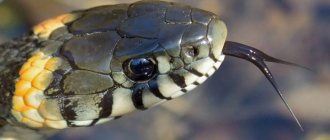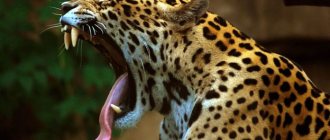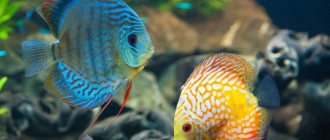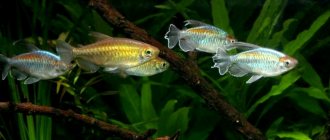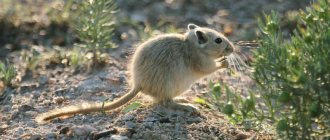Black mamba (Dendroaspis polylepis) - 3 meters long
In size, one of the most poisonous snakes on the planet is second only to its queen from the 6th line of our rating. It is also one of the most aggressive snakes in the world, as it often attacks for no apparent reason. And it is very difficult to escape from a black mamba. At short distances it reaches speeds of up to 11 km/h.
Black Mamba
An inhabitant of the arid regions of the African continent, it grows up to 4.5 meters and is the most dangerous representative of the mamba genus.
The snake is not only long, but also fast. In pursuit of the victim, it reaches a speed of 11 km per hour. It is interesting that it waits in ambush for its prey, choosing the same place for it.
When bitten, quite painful symptoms are observed, paralysis occurs, which leads to death. Without an antidote for snakebite, a person can die within 40 minutes.
7
Olive python (Liasis olivaceus) – 4 meters
This non-venomous snake, one of Australia's largest, is sometimes confused with the mulga, a venomous snake from the adder family. The olive python suffers primarily from this similarity, as it is often killed, mistaking it for a dangerous “double.”
Olive pythons are harmless to humans and feed primarily on small mammals, birds and reptiles.
Hieroglyphic python
It is also called rock python. The length of the largest representatives of this species exceeds 6 meters, and the weight can approach 100 kg. Medium-sized individuals usually grow up to 4.5 meters, their weight is about 45-55kg. Hieroglyphic pythons are common on the African continent and can be found in tropical jungles and savannas. In terms of food preferences, this type of python is not particularly different from other members of the family. Their snacks include rodents, birds and reptiles. A large rock python can easily eat a plump warthog and even a small alligator.
Common boa constrictor (Boa constrictor) - 4.5 meters
These chameleons of the snake world can fit into any habitat in which they live. The color of the common boa varies from green and brown to yellow or red.
Boa constrictors can be found in tropical Central and South America. They are excellent swimmers, although they prefer to live on land. They can eat anything - from birds to monkeys. Common boas are non-venomous and have small, hooked teeth that they use to latch onto prey before wrapping their entire body around it and squeezing it to death.
However, from hunters they often turn into prey, because there is a real hunt for the exotic skin of boa constrictors. Therefore, this snake species is listed as endangered.
Common boa constrictor, up to 5 m
The common boa constrictor lives in South and Central America, in the Lesser Antilles. Likes to settle in forests and areas near rivers and lakes. In some countries they are kept in private homes as hunters to kill pests.
The size of the snake varies greatly depending on the subspecies, quality and quantity of food. Most often, female boas are larger than males, the weight of average individuals is usually 10-15 kg, the weight of large representatives can be 27 kg. Boas can be classified as large snakes; they grow up to 2.5-3 m, sometimes there are specimens reaching 5.5 m.
They have a bright, spectacular, contrasting color. Boas are excellent swimmers; young specimens often climb trees, while adults try to live and catch prey on the ground. Life expectancy varies greatly depending on conditions, sometimes living up to twenty years.
Indian python, also known as light tiger python (Python molurus molurus) - 5 meters
This snake was once the queen of the jungles of India, Sri Lanka and the East Indies. Indian pythons are among the oldest species of snake and have tiny projections on their skin that indicate they may have once had legs. They are not poisonous, but have two rows of very sharp teeth that can cause a very painful bite.
Pythons prefer to eat mammals, and like the world's largest snakes, they kill their prey by strangulation. They are capable of killing a deer and swallowing it whole.
Indian pythons live up to 20 years and are considered very useful creatures for controlling pests such as rats and mice. In areas where people have killed snakes or destroyed their habitat, pests that carry dangerous diseases have become a serious threat to human health.
Light tiger python
It belongs to the subspecies of the tiger python and is also called the Indian python. It is a close relative of the dark tiger python, but is slightly smaller in size. These reptiles do not grow more than 5 meters. The light tiger python can be distinguished from other large snakes by a number of characteristics:
- The sides of the body are decorated with spots, with light splashes in the center.
- There are either pinkish or reddish stripes on the side of the head.
- A diamond-shaped pattern is visible, albeit blurred, at the front of the head.
- Compared to the darker subspecies, lighter tones predominate, made in brown, yellow-brown, red-brown and gray-brown shades.
This reptile lives in the forests of India, Pakistan, Bhutan, Nepal and Bangladesh.
King cobra (Ophiophagus hannah) - 5.6 meters
This is the largest venomous snake in the world. It is considered a very dangerous reptile, since its poison can cause the death of a person in 15 minutes. However, when possible, the king cobra avoids confrontation with people. And when attacking, in order to drive away a two-legged enemy, it can make two or three “idle” bites, saving poison for hunting.
The Latin name Ophiophagus hannah means "snake eater". And it is completely justified, because the diet of the king cobra mainly consists of other snakes, including poisonous ones.
King Cobra
She is also a hamadryad. Being the largest among all venomous snakes, the king cobra is inferior in the strength of its venom to many other representatives of the snake world. The longest individual, more than 5.5 meters, lived in the London Zoo, where it was brought from Malaysia. The average length of king cobras is usually within 3-4 meters. The weight of an adult can reach 6 kg, and particularly large individuals can weigh up to 12 kg. Hamadryads live in the south and southeast of Asia, choosing wooded areas. They often creep up to residential buildings. The king cobra hunts during the day. It is noteworthy that it feeds on its own kind, without making concessions even to its poisonous relatives.
Dark tiger python, also known as Burmese python (Python bivittatus) - 5.74 meters
This snake has a beautiful patterned coloring reminiscent of a giraffe's skin and is known for its calm disposition. Burmese pythons are often kept as pets.
In their natural habitat, these snakes can be found in South and Southeast Asia. Their diet consists of small mammals and birds, and, similar to the anaconda, Burmese pythons squeeze their prey until it suffocates. They then swallow the prey whole and may only feed two or three times a year.
Due to deteriorating habitat conditions and the demand for snake skin and flesh, these giant creatures are becoming an endangered species in the wild. However, in captivity their numbers remain high.
Reticulated python
It is one of the largest snakes living on our planet. Their habitat extends mainly to south and southeast Asia. Swedish researcher Ralf Blomberg managed to describe in his works “Giant Snakes and Strange Lizards” a specimen whose length almost reached 10 meters.
In New York's Bronx Zoo, there once lived a female specimen named Samantha, whose length reached 7 and a half meters. While in captivity, she delighted zoo visitors for a long time, but died in 2002.
When in the natural environment, reticulated pythons grow to more than 8 meters due to the diversity of their diet, which includes various vertebrates, including monkeys, small ungulates, rodents, reptiles, etc.
Interesting moment! The python often eats bats. To do this, the snake catches them in flight, clinging with its tail to the protruding parts of stone caves.
Pythons do not mind feasting on ungainly pets such as dogs, goats, birds, pigs and others. The most sought after pythons are young individuals weighing no more than 15 kg, although according to some statements the python swallowed pigs whose weight reached 60 kg.
Hieroglyphic python (Python sebae) - 6 meters
Adult hieroglyph pythons typically reach a length of 4.8 meters. But there is unconfirmed information that in 1958 a seven-meter python was killed, in whose stomach a 1.5-meter Nile crocodile was found. Now it is difficult to say whether this information was true, since there are no photos or videos of one of the largest snakes in the world.
These pythons also attack people. In 2002, a snake swallowed a ten-year-old boy in South Africa.
Reticulated brown snake
But this representative of the asp family can grow up to 2 meters 40 centimeters, although the average length does not exceed 1.8 meters.
She chose Australia and the large islands of Oceania as her habitat. It feeds mainly on rodents, so the snake can often be found on farms and near residential buildings.
The poison is used only in case of danger, and it releases quite a bit. But if there is a bite with a small dose of poison, the victim must receive medical assistance.
9
Amethyst python (Morelia amethistina) – 6 meters
This species is found in Indonesia, Australia and Papua New Guinea. The amethyst differs from other pythons in the large and symmetrical scutes that cover the upper part of its head. These snakes have a beautiful yellow-olive or olive-brown coloration with a rainbow tint.
Amethyst pythons feed on small animals (including chickens) and often crawl into the yards of people who keep birds.
Amethyst Python
This is the largest snake living on the Australian continent. Currently protected by Australian law. The length of adult individuals can reach 8 and a half meters, with a weight of at least 30 kilograms.
Average sizes, as a rule, do not go beyond 3 and a half meters. It differs from various types of pythons by the presence of large, symmetrically located scutes on the top of the head.
Experts determine that this is an amethyst python based on the following characteristics:
- The main body color is olive-brown or olive-yellow, with a peculiar iridescent tint.
- Black and brown contrasting stripes run across the body.
- Closer to the back, a grid-like pattern formed by dark and light stripes clearly stands out.
The amethyst python's diet includes small birds, lizards and small mammals. Often their victims are bush kangaroos and marsupial cuscus.
Important point! Indigenous people (aboriginals) claim that these reptiles attack domestic animals because they can identify their prey from afar by the heat emanating from it.
To ensure that domestic animals and living creatures do not serve as a source of food for the python, they are kept in special enclosures. In this regard, in Australia, parrots, rabbits, cats, dogs, and other animals are kept in cages.
Giant or green anaconda (Eunectes murinus) - 9 meters
There are many legends and rumors about the size of the anaconda. Briton Percival Fossett describes anacondas measuring over 18 and 24 meters. And in 2015, a photo of a giant anaconda 40 meters long and weighing 2067 kg, which allegedly killed 257 people and 2325 animals, spread across the Internet. It took British commandos in Africa 37 days to track and kill her.
However, this photo turned out to be a fake, and the largest anaconda specimen currently known is in New York, in the terrarium of the Zoological Society. She is about 9 meters tall and weighs 130 kg.
Green anacondas live primarily in the Amazon rainforest and can be found in swamps, rivers and streams. They are very agile in the water and never crawl far from it. Their diet mainly consists of iguanas, birds, turtles and other small to medium sized creatures. These scaly giants kill their prey by wrapping themselves around them and squeezing them in a deadly embrace, preventing them from breathing air. Their extremely elastic mouth allows them to swallow their prey whole, even if it is much larger than the anaconda itself. And it may take months before the snake wants to eat again.
Anaconda
One of the largest snakes in the world is the anaconda, the length of which reaches 10 meters, while the weight of an adult individual is over two hundred kilograms. The largest snake ever discovered by man now lives in the Zoological Society's terrarium in New York. The length of this anaconda is 9 meters, weight – 130 kilograms. The longest length of this snake recorded by man is almost 11.5 meters. Such an anaconda was discovered back in 1944 in Colombia during the search for “black gold.” Evidence in the form of the anaconda’s body was not preserved, because the snake, after being stunned, quickly came to its senses and disappeared into the thickets, however, this record was nevertheless included in the Guinness Book of Records.
Separately, it is worth mentioning the fact that in the 30s of the last century, the zoological community offered a reward of $1,000 to anyone who could prove the existence of an anaconda whose length would be greater than 12.2 meters. Theodore Roosevelt made amendments, reducing the size of the snake to 9.12 meters, but increased the reward by 6 times. Now the possible payment is 50 thousand dollars, but the lucky owner has not been found.
Separately, it is worth mentioning the Giant African Python, whose remains are more than 55 million years old. According to the spine, scientists claim that the length of the snake was 11.8 meters, but now the average length of an anaconda is 6 meters. Most often they live in the tropical forests of South America and the quiet backwaters of the Amazon. The anaconda feeds on mammals, first smothering them with its body and swallowing them whole. Having swallowed its next victim, the anaconda rests for several days and does nothing. Many horror films have been made about this snake, however, this snake is not dangerous to humans.
Reticulated python (Python reticulatus) - 14.85 meters
The largest snake in the world was found in the jungle on the island of Sumatra.
Its length exceeded 14 meters and its weight was 447 kg. Scientists have never seen a snake this size. The monster was given the name Guihua and entered into the Guinness Book of Records. It costs him nothing to swallow a person or even a medium-sized cow. And after such a meal, Guihua may not eat anything for several months. Regular reticulated pythons reach a length of 5-7 meters and are characterized by aggressive behavior. They can attack people and animals, both domestic and predators. In one of the videos with the largest snakes in the world, a python killed and swallowed a small alligator
These snakes are capable of dislocating their jaws in order to swallow prey close to their own weight and up to 1/4 the length of the body.
Despite the fact that the reticulated python is quite widespread in the wild, its numbers are gradually declining. Poachers actively hunt for snake skin, as well as gall bladder, which is used in Asian folk medicine.
Dark tiger (Burmese) python | 6-7 meters
In 4th place among the largest snakes on Earth is the dark tiger (Burmese) python . The average body length is 3.7 meters. But in nature there are individuals reaching 6-7 meters. The largest dark python kept in captivity reached 5.7 meters in length. His name was “Baby”. Distributed in Thailand, Cambodia, Vietnam, India, Indochina. Accidentally brought to Florida, he got along well there too. Like all pythons, it is active at night. Hunts rodents, birds, lizards.
The largest snake ever living on Earth
But even the world's largest reticulated python did not reach the size of Titanoboa. This extinct species of snake - a close relative of the boa constrictor - lived on Earth about 61-58 million years ago. The titanoboa's body length reached 15 meters, and it weighed about a ton.
There lived a giant snake in the humid and hot jungle in what is now Colombia. And if she had lived to this day, then Korney Chukovsky would have urged children not to walk not in Africa, but where this huge monster crawls.
10. Levant viper or viper Length 2 m
The Levantine viper opens the top ten longest snakes on the planet . Its size and appearance are more familiar to our nerves, since it usually has a length of 1.9-2 m and weighs up to 3 kg. Although it has the very last place in the TOP 10, the toxicity of the viper's venom is second only to cobra. It has a calm brown color with a dark pattern on the back, and differs from other members of the family by sharp scales on the head. The Levant viper loves arid climates and areas without vegetation; it is common in Transcaucasia, Africa and Asia.
3. Burmese python or dark tiger Length 5.8 m
Among pythons with a color like a tiger, this species will be the largest. It lives in Asian countries such as China, Thailand, Indonesia, Vietnam, and also in India. The record length of the Burmese python was 8-9 m with a weight of 70 kg, but specimens with a length of up to 5.8 m are most often found. Such dimensions allow us to place the tiger python in third place in the ranking of the longest snakes in the world. Pythons love swampy areas and tropical rainforests. They are excellent swimmers, and light-weight young individuals can nimbly climb trees. A calm python, sitting in a secluded place, can determine the location of prey using thermolocators, capturing thermal radiation and smell. It eats birds, rodents, monkeys, but can attack a pig or goat. These snakes are often kept as pets, although this is an expensive hobby.
Among tiger pythons there are albinos, which have a very beautiful yellow-white color.
8.Surukuku or bushmaster Length 4 m
This viper is the most poisonous and longest snake in South America. The average length is 2.5-3 m, but larger specimens are also recorded: up to 4 m. The weight of this representative of pit snakes is 3-5 kg, but even such impressive dimensions do not add aggressiveness to the surukuk, like the eastern brown snake. The bushmaster is shy and cautious, and is rarely seen by humans. While waiting for his prey, he is able to sit in ambush for more than one week! It differs from other snakes in its bright coloring: large black diamonds on a yellow-brown body.
The largest crocodiles
Saltwater crocodile
Saltwater crocodile - size
Of the living reptiles, the largest is the saltwater crocodile. It is also called the saltwater crocodile and the man-eating crocodile. These reptiles attack people. They are found in eastern India, the states of Indo-China, and northern Australia. They live in lagoons, river mouths, and swamps.
There are individuals up to seven meters long and weighing up to two tons. Five-meter long saltwater crocodiles are a common sight. They say that previously they found man-eating crocodiles ten and a half meters long.
Nile crocodile
Nile crocodile
The Nile crocodile reaches large sizes. Its length ranges from two to five and a half meters. According to some reports, ten-meter specimens were also found. The record length of an alligator living on the American continent is 5.8 meters. Weight - more than a ton.
Burmese python
If we decided to talk about giant snakes, then it would be wrong to remain silent about this python. Its length can reach 7 meters. And this handsome guy weighs 100 kg.
This snake is not poisonous. However, it does not have to be poisonous to be dangerous to humans. The reptile kills people every year. A large number of such cases have been recorded.
However, this is the exception to the rule. Because in fact, the Birman's diet includes large birds, large mammals and, of course, livestock.
Aborigines believe that this giant is able to protect the house from demons, evil spirits, if it is placed in a home.
